As I mentioned in my last post, I’ve been learning Aikido at the Aikikai Hombu Dojo in Tokyo. Recently my sempai Eric, who posts some great info about Hombu Dojo, suggested I write about the “Aikido Gakko” (合気道学校 – Aikido School).
Updated: I’ve also posted about Intermediate Gakko.
The basic information about the “Aikido Gakko” is covered on the Aikiaki web site, in English and Japanese. In this post I’ll talk about some of my experiences in the beginner course (初級課程).
Updated: Applications for the 2010 summer course are now closed.
Applications for the 2010 summer course are now open, so I thought I’d try to get something written sooner rather than later (this is a little rushed, I might try to clean it up later). The admissions for the beginners class are on a first-come first-served basis and the places normally fill up, so if you want to attend try to get in quick.
Starting Out at Hombu Dojo – Prior to the Gakko
I started training at Aikikai Hombu Dojo Tokyo in August 2008. At Hombu Dojo the normal classes (not the “Gakko”, which I’ll talk about shortly) are separated into two different levels – the “shoshinsha” (初心者 – beginner) class on the 2nd floor, and the “ippan” (一般 – regular) class on the 3rd floor. Naturally I was attending the beginners class, mainly on Saturday mornings.
Despite the name, I found the “beginners” class quite difficult. It’s common to cover 5 or more techniques in a one hour lesson, and the techniques come from a fairly large list, so I found it hard to get a handle on the similarities and differences between the techniques. The beginners class generally covers techniques up to and including the 3rd kyuu (the lowest level is 5th kyuu), but I’ve seen gokyo (fifth pin) taught, which doesn’t show up on the grading schedule until 1st kyuu. After 6 weeks of training I was only just starting to find my feet (pun intended).
It was around this time I saw the signs up at the dojo for the “Aikido Gakko”, the mysterious lessons that happen on the 4th floor of the the dojo. Despite some reservations, and thanks to the advice of a friend, I applied for the October 2008 beginners course and was lucky enough to get a spot.
Beginners Gakko vs Beginners Class
So, how is “Beginners Gakko” different from the regular “Beginners Class”? The “Beginners Gakko” assumes you are completely new to Aikido. As such it offers a great way to start learning Aikido from the very foundations.
In our first lesson we were taught hanmi (半身 – correct stance), ashi sabaki (足裁き – how to move your feet), and basic ukemi (受身 – how to receive the technique and fall safely), as well as the beginnings of the first pin technique, ikkyo (一教). It sounds obvious that these would be taught, but these topics aren’t usually covered explicitly in the normal beginners classes, so it really helped.
After that the techniques were introduced at a nice gentle pace, with plenty of reinforcement and a progression that made them much easier for me to absorb than I had found in the normal classes. For instance ikkyo, the first pin, was introduced as the katatedori (片手取 – single hand is held) version, and only doing the omote (表 – front side) version, where you move in front of your partner. The technique was broken down into a series of movements and practiced. This was repeated in the second lesson, after which the ura (裏 – back side) variation, moving behind your partner, was introduced. At a later stage the shoumen uchi (正面打 – front strike) variation of ikkyo was introduced, adding the element of timing.
Through a combination of the logical progression of the techniques, the extra reinforcement, the fact that the techniques were broken down into steps, the lack of “technique overload”, and just plain more time on the mat, I felt was able to remember the techniques much quicker. By the end of the semester we were covering all the techniques required for the 4th kyuu test (skipping the 5th kyuu test), plus quite a few more, and while it was challenging I never felt like it was overwhelming.
Take That!
Another huge benefit of the beginners gakko is the emphasis on ukemi (受身) – “receiving” the technique – basically getting thrown. It’s very important to learn to fall properly to avoid injury. In particular, Kanazawa Shihan spent a lot of time teaching us ushiro ukemi (後ろ受身 – falling backwards), for which I was especially grateful. There is also the important matter of how to “attack” correctly, and both Seki Shihan and Kanazawa Shihan place particular emphasis on this.
It’s common to see students in the regular beginners class who don’t have the experience to take ukemi very well. Good ukemi is something to work on continually, and beginners gakko gets you off to a good start.
Teachers
I can’t talk about the “Aikido Gakko” without making a special mention of the teachers. The beginners classes of 2008 and 2009 were taken by Seki Shihan (関師範), 7th dan, and Kanazawa Shihan (金沢師範), 6th dan. Classes were taken by Waka Sensei when the regular teacher was available. These teachers are living legends in the Aikido world, and it’s an amazing opportunity and an honour to learn from them. They take the role very seriously, clearly explaining the techniques and offering their advice on how to improve.
One of the main benefits of the gakko is the increased opportunity to act as uke (受け - the person receiving the technique) for the teachers, compared to the regular classes. It was not uncommon for the teachers to “make rounds” through the class, giving each person the opportunity to act as uke. Additionally, if you are lucky enough you may get called up to act as uke while the teacher demonstrated the techniques for the class (this is generally reserved for those taking the course a second time). Even though they were definitely dialing down their energy level for us beginners it was still quite an experience to feel the power when being thrown by the teachers.
I still remember the “punch” of Seki Shihan’s ikkyou (一教 – first technique), it really feels like he is going to drive your shoulder straight back through your face.
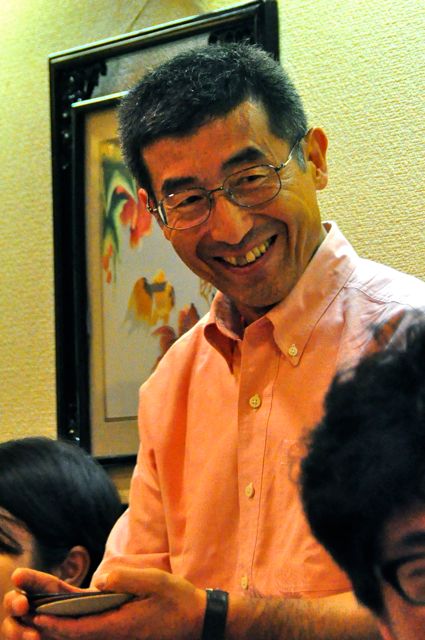
‘Seki Sensei, 2009’
I also remember Kanazawa Shihan’s iriminage (入身投 – entering throw), getting swept completely off my feet, sucked in as he brings you into his shoulder, and then the force behind his throw as he drives you into the ground.
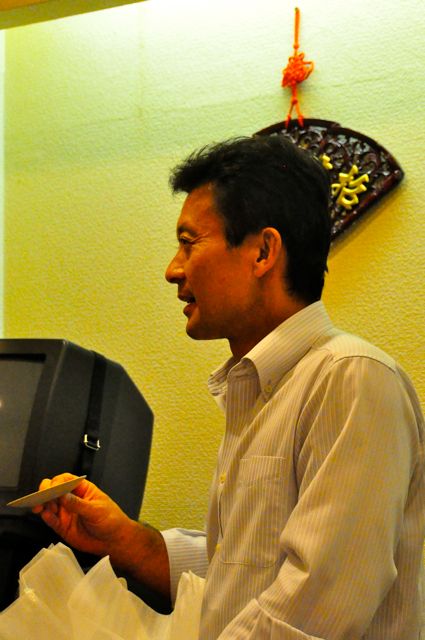
‘Kanazawa Sensei, 2009’
Say What…?
The biggest issue for me in deciding whether to sign up for the Gakko, and I assume for most “gaijin” (外人 – foreigner, literally “outside person”), was language. I was lucky that I’d been studying Japanese for a few years before signing up, and had some basic ability, but I’d never really had to rely on it for anything practical and my speaking ability was almost non-existent. I had serious doubts about signing up for the Gakko, but since I’d managed to fumble my way through some of the normal beginners classes I took the plunge.
I remember entering the first class to find about 20 students, but only one other gaijin, an Italian woman who was sitting there chatting away in Japanese. Needless to say I was starting to feel very nervous. After a brief introduction from the Doshu (道主 – the head of the Aikikai) we spread out in a circle and were asked to introduce ourselves! By this time I was starting to regret signing up. I did my best in my broken Japanese, hoping what came out was at least partially intelligible. After that it was into the training, and I didn’t have to speak.
At the end of the first lesson we also received a text book, which is included in the fees, and an English edition is available if you choose.
After that the language wasn’t such a big issue for me. At first I could only understand about 30% of what the teachers were saying, and they actually explain quite a lot (much more than the regular beginner classes), but it was usually fairly obvious what they meant from the context. My prior experience in Australia and the beginners classes helped a little to fill the gaps in my language understanding. There were certainly times when I didn’t understand, but nothing that interfered with me improving my Aikido, or my enjoyment of the class. It didn’t take too long to learn some new vocabulary, some of which is specific to Aikido, and that helped my understanding a lot. By the end of the semester, 5 months later, between my exposure at the dojo and quite a bit of study, I could understand about 60% of what was being said, and understand what was going on almost all of the time, at least during the practice. Talking to other students was another matter entirely!
For foreigners with absolutely no Japanese, the Aikido Gakko will be quite difficult. But because the techniques are introduced slowly I think it will be easier to understand than the normal classes. You can mostly get by with watching the teacher carefully, and guessing from the context. You’ll also learn the most important words quite quickly, as they’ll be repeated very often. If all else fails there will usually be at least one person who speaks some passable English who can get the point across.
Making the Grade
Towards the end of the semester the teachers began mentioning the “shinsa” (審査 – judging) – the grading test for kyuu levels. There’s a minimum requirement to attend 60% of the classes in order to be able to graduate and take the test, which means you have to attend about 26 classes. They gave us plenty of warning of the date, and were kind enough to actually give us a run-down of the techniques we would be expected to do (for both 4kyuu and 3kyuu). First time students can take the 4th kyuu test, while those taking the course for the second time (or those who already have 4th kyuu grade before entering) can take the test for 3rd kyuu. Soon after that the teachers began splitting the class during training, so that those taking the 3kyuu test could learn and practice the higher level techniques, while us first-timers focused on the basics required for 4kyuu. We even spent a some time practicing where to sit and how to bow correctly during the test.
We were able to choose our partners for the test, and I was delighted that one of my first friends from Hombu Dojo, Hirata san, asked me to be his partner. I was fortunate, Hirata-san’s technique and ukemi are excellent. We often spent extra time after class practicing the techniques for the test, and the number of people staying around after class for that extra bit of practice noticeably increased.
I think everyone was fairly nervous for the test. The test was taken in groups of 3 or 4 at a time, meaning we weren’t exactly under the spotlight, but it was hard to ignore the thought of the teacher’s gaze. Despite a few students forgetting the odd foot movement or hand placement, resulting in some prompting and gruff words from the teacher, it was announced that everyone had passed. Everyone was visibly pleased. A few days later the grading results from all levels of the gakko were posted on the wall on the 2nd floor of the Dojo.
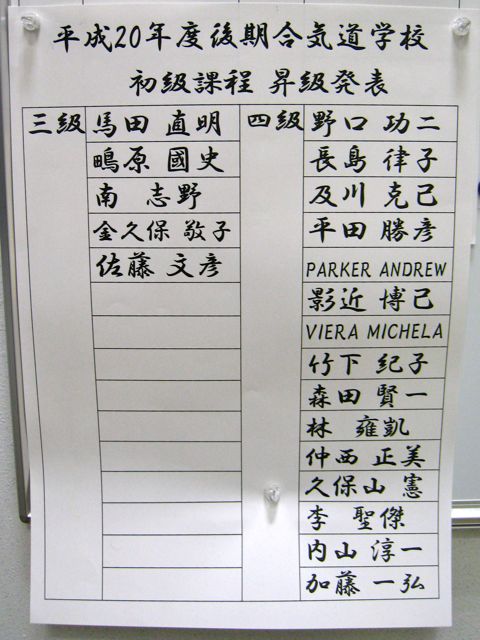
‘4th Kyuu, my first grading, 2009’
Sadly this also signaled that the semester was almost over. All that remained was one more training session, and then the “shuryoushiki” (終了式 – final ceremony) where we received our “graduation” and kyuu certificates. The Doshu once again made an appearance for the final ceremony, at which he presented certificates to the class and kyuu representatives before giving us a short speech congratulating us and encouraging us to continue on with Aikido.
The final ceremony was followed by a group dinner, accompanied by the teachers. This was a great opportunity to “meet” the teachers outside the confines of the 4th floor dojo, and get to hear some of their insights about Aikido. I felt like an eager child, hanging on their every word. Unfortunately my Japanese level was not really good enough to understand a lot of what was said, but I did understand a little and it was a fun night.

‘Ueshiba Mitsuteru, Waka Sensei, 2009’
Making Friends
One of the other benefits I hoped to get from going to Aikido Gakko was to meet people and make friends. It took a while for this to happen. There wasn’t a lot of talking during practice, and most people disappeared as quickly as possible after the practice was finished. This coupled with my almost non-existent speaking ability, and my difficulty dealing with large groups of people I don’t know, meant it was quite a while before I started to really interact with anyone. But gradually I made a few connections with the other students (asking your partner’s name is a good start!), and as we practiced together I slowly got to know a few people. Going through the grading tests together at the end of semester also helped to strengthen those friendships, as you feel like you’ve helped each other achieve something.
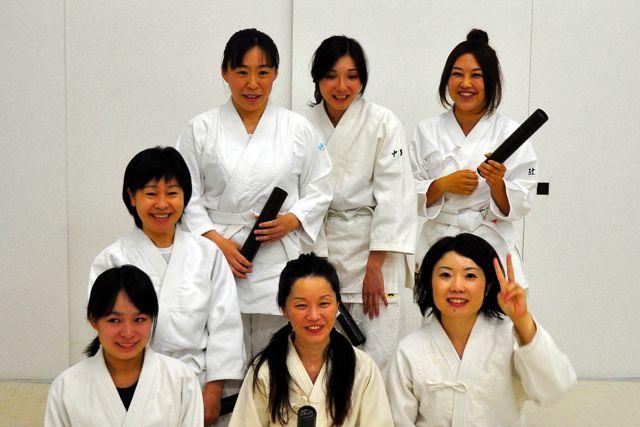
‘The girls from beginners class 2009’
We have occasional “nomikai” (飲み会 – drinking party) where we catch up, and even see some of the students who, for various reasons, have not been able to continue on with the Aikido gakko. The end result is that I’ve made quite a few friends. This alone has made the experience of Aikido Gakko well worth it for me.
Once More For Effect
In April 2009 I signed up for a second semester of beginners gakko. This gave me a good chance to review and solidify all the techniques in my head, and the opportunity to try to learn how to do them “properly” – or at least a little better than before. This time I was also one of the “sempai”, a (slightly) more experienced student who could help the first-timers, if only a little bit, as well as the chance to take a bit more ukemi from the teachers.
The pace of the summer semester started a little faster than the winter course, making it a bit harder for the newbies. This was because of the soon-approaching “embu” – the 47th All Japan Aikido demonstration. As a student of the Aikido Gakko summer course you are expected to perform a 2 minute demonstration with your fellow students in May. The teachers instructed us to pair up as first-time and second-time pairs. My partner was Shishido san, the most energetic student in the class. It was fun to train at a bit of a faster pace, at least until I was worn out! We were given a short list of techniques, and some time spent practicing them. I couldn’t actually remember that much about the demonstration after doing it, it was a bit like a dream. But it was a great experience. I also got to stay around afterward and chat to one of my fellow classmates, Kuwano san, and watch some of the amazing Aikido, including the final demonstration by the Doshu.
The new students entering the course also meant a new group of friends, and this group were also a bit more socially outgoing than the previous semester. My Japanese was slowly improving, which meant that I could start to take part in social activities a bit more – there’s nothing better for your Japanese listening ability than spending 3 hours in an izakaya (居酒屋 – a japanese pub) after training, listening to a bunch of people talk about Aikido!
Once again as we got near the end of the semester the class was often split into two groups, this time I was in the group that was being taught the extra techniques needed for 3rd Kyuu.
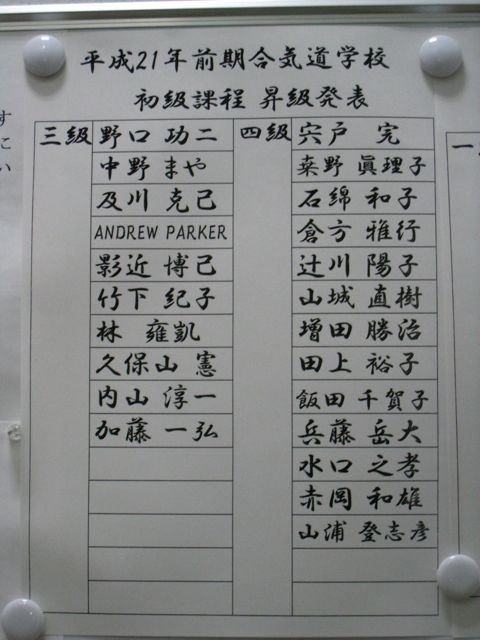
‘3rd Kyuu, 2009’
Overall I found the second time through the course just as rewarding as the first.
Shortcomings?
So are there any shortcomings with doing the Aikido Gakko? Not really.
The set schedule can be difficult. Classes begin at 6:30pm, which meant leaving work early for me. Having a class on Monday night also means it’s hard to take a long weekend. You don’t have to make every lesson, but the “shusseki” (出席 – attendance) is called at the end of every class and if you don’t attend enough classes you won’t “graduate” or be able to take the test with the rest of the class (apparently your lessons will still count towards training requirements for the regular tests). But that’s all part of the commitment you make in signing up. Apart from a few people who dropped soon after the start of the course I think most people managed to make the required number of classes fairly easily.
I said that the beginners course gives a good introduction to ukemi (falling), but mae ukemi (前受身 – forward roll) is not really taught in beginners gakko, simply because none of the techniques require it (it is taught from the start of intermediate gakko). For those desperate for a “taste” outside gakko, Kobayashi Shihan covers mae ukemi and shikko (knee walking) in the beginners class on Saturday mornings, although I’d recommend asking for help from a sempai (senior student) before attending that class to get the basic idea. Rolling isn’t easy to learn, and I’ve seen a few newbies show up and be the only person who can’t roll in front of the whole class, which can be a bit embarrassing.
It’s not a shortcoming of the beginners course, per se, but you get the most benefit if you also attend some classes outside the gakko. This lets you experience the Aikido of different teachers (there’s more variation in style than I expected), but more importantly, it gives you more time on the mat, and the experience of feeling how the “yudansha” (有段者 – blackbelts) act as uke and do the techniques. By the end of a year of gakko it begins to be apparent which students have only attended gakko and which have been attending extra classes.
Finally there’s the cost. The beginners course is 52500円, which is very good value considering it’s about 40 x 90-minute lessons over 5 months, and the amazing teachers you are learning from. Extra classes at Hombu Dojo are not covered by the course fee. If you want to attend some extra classes you can pay per-lesson, at about 1600円 per day. If you think you’ll take extra classes more than 6 times in a month, it’s cheaper to pay for the month up-front the first time you practice (about 10500円). But this means you can end up paying roughly 20000円 per month, which isn’t exactly pocket change. You can definitely get more “training time for your yen” by just paying the monthly fee and going to the beginners class every day, but then you don’t get the same experience as the gakko. In the end I attended some extra classes outside gakko, varying from month to month whether I payed per-lesson or up front.
Final Words
In short, if you are considering signing up for the “Beginners Gakko” at Aikikai Hombu Dojo, and you can afford it and commit to the class times, I say go for it. The experience was amazing and one I will never forget.
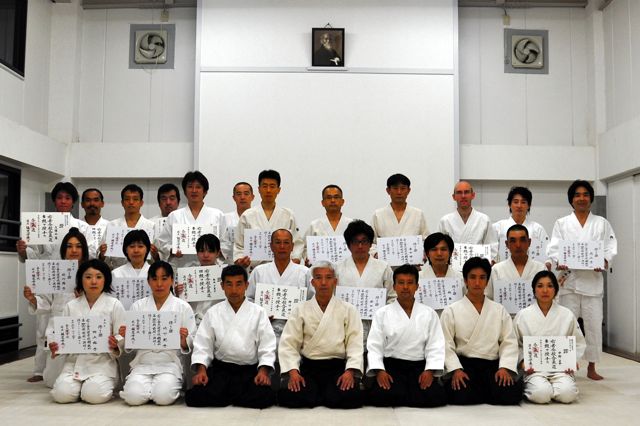
‘Beginners Gakko Class Graduation, August 2009’